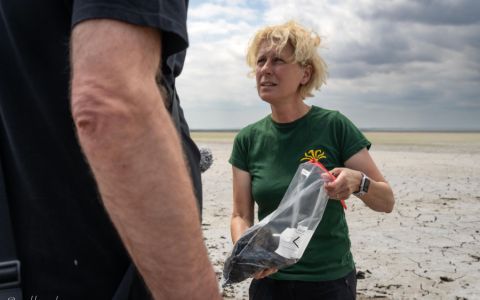Despite the highly toxic air in Bosnia and Herzegovina (BiH), only limited data on the pollution is accessible to the public. The government is failing to meet its international obligations, obligations to uphold domestic laws, and publish and the transparent register of major polluters. People, thus, do not know who is really poisoning them, to what extent, and cannot effectively enforce the necessary improvements.
Obsolete industrial giants, together with weak enforcement of environmental legislation, corruption, and an overcomplicated structure of the state authorities are all to blame for air pollution according to experts.
"According to domestic law, major polluters in Bosnia and Herzegovina are to provide data on their emissions to the state authorities and have been responsible for their verification and publishing since 2002 and 2003, respectively [1]. Unfortunately, information is not publicly available even now. As a result, it is virtually impossible to check whether the industry follows permitted levels of pollution, and it is not possible for citizens to learn who is polluting their environment. Our alternative website Eko.ba brings the citizens at least the information that is available; although, because of the lack of data, we unare able to present the whole picture,” said Martin Skalský from the Citizens Support Center of Arnika Association (Czech Republic).
"In reality, the data collected from polluters is available only upon official request, which is usually answered by the respective authorities after long delays, and applicants often receive the information too late to be able to use it in decision-making procedures," says Professor Samir Lemeš, president of the Steering Board of the Zenica NGO Eco Forum. According to him, "there is a possibility that the authorities act in favor of polluters, using the poor economic situation and low employment rate as an excuse to hide emissions data from the public. Meanwhile, air pollution, especially with dust and sulfur dioxide (SO2), is significant in our country.”
The Western Balkan country has not ratified the Pollutant Release and Transfer Register (PRTR), a mandatory information tool for the signatories of the PRTR Protocol to the UNECE Aarhus Convention on environmental democracy [2], signed by BiH back in 2003. Since a publicly accessible online register is one of the EU's demands within the approximation of environmental legislation, at least the authorities of the Federation of BiH started some preliminary stages. The Ministry of the Environment of the FBiH issues annual reports on the data provided by the polluters though these numbers are unverified from an third party. Meanwhile, no data exists from the Republika Srpska of BiH [3] where some of the main polluters are located: the Gacko, Ugljevik, and Stanari coal power plants.
Top polluters revealed
At the 6th Conference of Parties to the UNECE Aarhus Convention in 2017 [4], insufficient access to information on environmental issues was recently discussed by Czech and Bosnian experts in an analysis presented. Allegedly, nothing has changed to this day. The environmental responsibilities are fragmented and the only state-level institution tasked with collecting and reporting data from both entities is the Ministry of Foreign Trade and Economic Relations.
This week, environmentalists published a list of Bosnia-Herzegovina’s worst polluters [5]. The top ten is dominated by ArcelorMittal Zenica, the Tuzla thermal power plant, and the chemical factories in Lukavac. However, the missing or incorrect data from the polluters has presumably influenced the comparison, experts say.
Bosnia and Herzegovina is among the countries with the polluted air bridge in Europe with one of the highest levels of mortality from air conditions globally [6]. According to the UN Environment, 44,000 years of life are lost each year as a result of particulate matter (PM), nitrogen dioxide, or ozone pollution in Bosnia and Herzegovina. Air pollution costs over 21.5% of the country's GDP [7]. Also, cities in Bosnian-Herzegovinian are at the top of the European list of places worried polluted with PM 2.5 dust particles [8].
Remarks for editors:
[1] 'Law on the Protection of the Environment (Official Gazette FBiH, No. 33/03), Article 28' and 'Republika Srpska of BiH: Law on the Protection of the Environment' and 109/05), Article 102 '
[2] The Kiev Protocol on Pollutant Release and Transfer Registers is an amendment to the UNECE Convention on Access to Information, Public Participation in Decision-making and Access to Environmental Matters and became an international law that was binding on its signatories on 8 October 2009. It aims to enhance public access to information through the establishment of coherent, integrated, national registers, which could help public participation in environmental decision making and also contribute to prevention and reduction of pollution. ( https://prtr.unece.org/ )
[3] The country of Bosnia and Herzegovina is formed of a Serbian entity (Republika Srpska) and a Muslim-Croat entity (Federation of Bosnia and Herzegovina). The central government ties both together in a fragile state.
[4] In September 2017, Arnika published by Aarhus Convention implementation for Bosnia and Herzegovina. The Environmental Democracy: Progress Unreported study was then presented at the International Meeting of Parties in Budva, Montenegro.
[5] Who poisons the air in Bosnia-Herzegovina? Top 10 shows the worst industrial polluters (Arnika.org)
[6] According to the most up-to-date WHO statistics (Who.int), “Bosnia and Herzegovina, Bulgaria, Albania, and Ukraine have the highest European mortality rates attributed to home and air pollution. Many of these same countries, as well as the Former Yugoslav Republic of Macedonia, Poland, and Hungary, have the highest average annual levels of city air pollution. On both spectra, Bosnia and Herzegovina is listed as the worst European performer. ” Which European countries are the bridge polluted? (Euronews.com)
[7] Coming up for clean air in Bosnia and Herzegovina (UnEnvironment.org)
[8] Worldʼs most polluted cities 2018 (PM 2.5 ) - The list, put together by the AirVisual monitoring portal, only includes cities with available data for PM 2.5 . This surely excludes some highly polluted cities where these particles are not being monitored, for example the two largest cities of Bosnia and Herzegovina, Sarajevo and Banja Luka.







